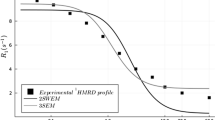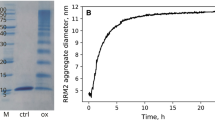Abstract
Previous works showed a significant increase in the rotational correlation time of the water bound to the hemoglobin S during the aggregation process under sickle cell disease. In this case, the contribution of “Curie-Spin” relaxation mechanism to proton relaxation may be expected. The Curie-Spin relaxation mechanism has been well described theoretically but only a few experimental evidences have been presented. Based on the reported correlation times, the contribution of the Curie-spin relaxation mechanism to proton relaxation times (\({T}_{1}\) and \({T}_{2}\)) has been estimated in comparison with the contribution of the dipole–dipole relaxation mechanism at the extreme stages of the aggregation process of the hemoglobin S. This contribution is about 25% and 50% in the spin–spin relaxation rates at the magnetic field of 1.5 T during the latent and ending stages of the aggregation process, respectively. At lower magnetic fields, this mechanism gives an insignificant contribution. The contribution to the spin–lattice relaxation is negligible even at 1.5 T. In particular, this relaxation mechanism should be taken into account when interpreting experiments related to MRI.
Similar content being viewed by others
References
M.B. Taraban, R.A. DePaz, B. Lobo, Y.B. Yu, Anal. Chem. 89, 5494 (2017)
X. Li, R.W. Briehl, R.M. Bookchin, R. Josephs, B. Wei, J.M. Manning, F.A. Ferrone, J. Biol. Chem. 277, 13479 (2002)
A.F. García, C. Cabal, J. Losada, E. Álvarez, C. Soler, J. Otero, Hemoglobin 29, 181 (2005)
A.A. Fernández, C.A. Cabal, M.A. Lores, J. Losada, E.R. Pérez, Hemoglobin 33, 206 (2009)
G. del Toro García, J.E.F. Dieguez, Y.A. Geli, Y.C.V. Rodríguez, C.A. Cabal, Bioquimia 28, 4 (2003)
M. Lores, C. Cabal, Appl. Magn. Reson. 28, 79 (2005)
A.A. Fernández, M.A. Lores, E.R. Pérez. Rev. Cuba. Quím. 14, 59–63 (2002)
M. Lores, C. Cabal, O. Nascimento, A.M. Gennaro, Appl. Magn. Reson. 30, 121 (2006)
M.A. Lores, C.A. Cabal, R. Muller, S. Laurent, Y.M. Torres, J.C. García, in Magnetic Resonance and Its Applications (2019), pp. 98–98
M. Gueron, J. Magn. Reson. 1969(19), 58 (1975)
A.J. Vega, D. Fiat, Mol. Phys. 31, 347 (1976)
P. Caravan, M.T. Greenfield, J.W.M. Bulte, Magn. Reson. Med. 46, 917 (2001)
I. Solomon, Phys. Rev. 99, 559 (1955)
V.I. Chizhik, Y.S. Chernyshev, A.V. Donets, V.V. Frolov, A.V. Komolkin, M.G. Shelyapina, Magnetic Resonance and Its Applications (Springer International Publishing, Cham, 2014)
M.H. Levitt, Spin dynamics: Basics of Nuclear Magnetic Resonance, 2nd edn. (John Wiley & Sons, Chichester, 2008)
M. Rubinstein, A. Baram, Z. Luz, Mol. Phys. 20, 67 (1971)
D. Fiat, A.M. Chmelnick, J. Am. Chem. Soc. 93, 2875 (1971)
T.J. Swift, R.E. Connick, J. Chem. Phys. 37, 307 (1962)
Acknowledgements
The reported study was funded by RFBR and CITMA according to the research project no 18-53-34003.
Author information
Authors and Affiliations
Corresponding author
Additional information
Publisher's Note
Springer Nature remains neutral with regard to jurisdictional claims in published maps and institutional affiliations.
Rights and permissions
About this article
Cite this article
Cabal, C., Lores, M., Chizhik, V.I. et al. Assessment of Contribution of Curie-Spin Mechanism in Proton Relaxation During Aggregation Process of Hemoglobin S. Appl Magn Reson 51, 1647–1652 (2020). https://doi.org/10.1007/s00723-020-01241-x
Received:
Revised:
Published:
Issue Date:
DOI: https://doi.org/10.1007/s00723-020-01241-x




